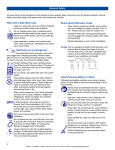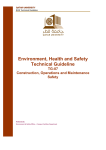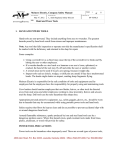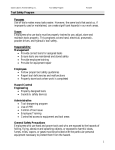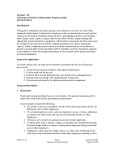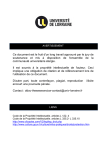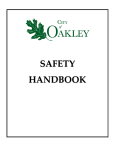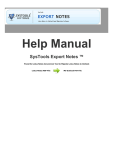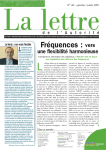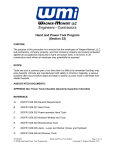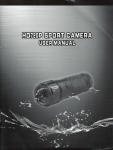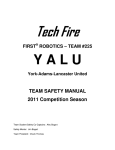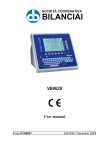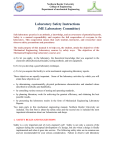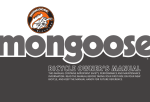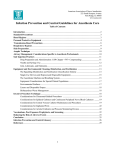Download MFA Safety Manual - Boise State University Department of Art
Transcript
SAFETY MANUAL MFA FACILITIES Department of Art FAB 115 and 115A TOOL SHOP August 27, 2013 TABLE OF CONTENTS INTRODUCTION ...................................................................................... 1 GENERAL SAFETY PROCEDURES .................................................. 1 EMERGENCY RESPONSE .......................................................................... Contacting 911 and Other First Responders ................................................. Alerting Secondary Contacts ......................................................................... 1 1 2 FIRE .............................................................................................................. Your Role In A Fire ........................................................................................ Assessing A Fire ........................................................................................... Large Fire ...................................................................................................... Small Fire ...................................................................................................... Fire Extinguisher Location ............................................................................. Fire Extinguisher Use .................................................................................... If Clothing Catches Fire ................................................................................. 2 2 3 3 3 3 4 4 PROPER SHOP ATTIRE .............................................................................. Shoes ............................................................................................................ Clothing ......................................................................................................... Hair ................................................................................................................ Jewelry .......................................................................................................... Eye Protection ............................................................................................... Ear Protection ............................................................................................... Respiratory Protection ................................................................................... Gloves ........................................................................................................... 5 5 5 5 5 5 5 5 5 USING MACHINES AND POWER TOOLS ....................................... 6 GENERAL RULES FOR THE USE OF MACHINES AND POWER TOOLS . Before Operation of a Machine or Tool ......................................................... General Formula for Working Safely and Efficiently ..................................... 6 6 7 SPECIFIC GUIDELINES FOR THE USE OF HAND TOOLS ........ 8 MISUSE OF HAND TOOLS .......................................................................... 8 HANDLING AND TRANSPORTING HAND TOOLS ..................................... 8 HAND TOOL INSPECTION .......................................................................... 9 ii Table of Contents, cont. HELPFUL ADVICE FOR USING HAND TOOLS .......................................... Punches and Chisels .................................................................................... Screwdrivers ................................................................................................. Hammers ....................................................................................................... Knives and Razor Knives .............................................................................. Wrenches ...................................................................................................... Pliers, Nippers and Snips .............................................................................. Long Handled Tools (Shovels, mops, brooms, etc.) ..................................... 10 10 10 10 10 10 11 11 SPECIFIC GUIDELINES FOR THE USE OF PORTABLE POWER TOOLS ....................................................................................... 12 PORTABLE POWER TOOL SAFETY ........................................................... 12 HAZARD RECOGNITION ............................................................................. 13 General Power Tool Precautions .................................................................. 13 MACHINE GUARDS AND SAFETY SWITCHES .......................................... 13 Guards .......................................................................................................... 13 Safety Switches ............................................................................................. 14 ELECTRIC TOOLS AND GROUNDING ....................................................... 15 STANDARD OPERATING PROCEDURES FOR PORTABLE POWER TOOLS ......................................................................................... 16 ELECTRIC DRILLS ....................................................................................... 16 SAWS ............................................................................................................ Electric Circular Saws ................................................................................... Kickback and Overheating ............................................................................ Cutoff Saws ................................................................................................... Electric Reciprocating Saws .......................................................................... 16 16 17 18 18 ELECTRIC SANDERS .................................................................................. 19 POWERED ABRASIVE WHEEL TOOLS ...................................................... 19 GENERAL NAIL GUN SAFETY .................................................................... 20 OTHER PNEUMATIC TOOLS ...................................................................... 21 iii OPERATING PROCEDURES FOR STATIONARY TOOLS & MACHINES .................................................................................... 23 DRILL PRESS ............................................................................................... 23 BELT, DISC, AND OSCILLATING SPINDLE SANDERS .............................. 24 TABLE SAW .................................................................................................. 25 MITRE SAW .................................................................................................. 26 PLANER ........................................................................................................ 27 CLEAN UP POLICY ................................................................................. 29 iv SAFETY MANUAL MFA FACILITIES FAB 115 and 115A TOOL SHOP INTRODUCTION This document describes operating procedures and practices for the FAB 115 and 115A Tool Shop rooms. It is the goal of this document to anticipate and provide information regarding the many risks associated with the use of power tools, hand tools, and other equipment in this room. This document may not cover all possible risk. For that reason, this safety manual is best used as a guide and cannot be expected to be comprehensive in the definition of all risks; however, it is intended to inform users of the key risks of the shop and proper behaviors to reduce risk of injury and/or accident. Common sense and knowledge of safe work practices will also be needed in ensuring safety for other areas in the MFA facilities not covered by this document. The procedures in this manual are understood to apply not only to tools provided by the art department, but also to any tool or machine that is the personal property of students working in the MFA facilities. Depending on the operation that a user is performing, additional instruction, procedures, and/or work permits may be required. When unsure, users are required to seek guidance from the graduate program director and/or other experts. It is mandatory that all individuals who use FAB 115 or FAB 115A be fully aware of this document’s existence and have a complete understanding of its contents. Therefore all users are required to sign, in the presence of the graduate program director, a Contract Statement. By signing this contract, the user acknowledges he/she has been informed of the risks associated with the use of these facilities, and has been instructed in safe practices and procedures required therein. GENERAL SAFETY PROCEDURES EMERGENCY RESPONSE Contacting 911 and Other First Responders If you feel your safety is in question, evacuate the room and dial 911 from any telephone. Identify yourself, your location, the location and type of incident and if an evacuation is underway. TOOL SHOP LOCATION: FINE ARTS BUILDING, ROOM 115 OR 115A 2249 UNIVERSITY DRIVE 1 Answer any questions and do not hang up the phone until the operator is finished. If you feel the safety of others in the FAB building is in question, pull the fire alarms located next to the building exits on your way out. The alarm will alert other occupants of the building to evacuate and campus and city fire response teams will be notified. It is not your responsibility to clean up hazardous or unknown materials, or to do any further investigation of a possible emergency. Your responsibility is to dial 911. IF YOU DO NOT DIAL 911 IN AN EMERGENCY, YOU ARE JEOPARDIZING YOUR HEALTH AND SAFETY, AS WELL AS THE SAFETY OF OTHERS. If there is indecision as to whether the incident constitutes an emergency, dial 911 or contact the University Security nonemergency number (426-1453) and they will dispatch an officer to evaluate and determine if other responders (e.g., fire, hazmat) need to be notified. REMEMBER: NO ONE WILL GET IN TROUBLE FOR CALLING 911. Alerting Secondary Contacts After calling 911 in an emergency situation, or in non-emergency situations, it is important that you inform the Art Department Chair and the Graduate Program Director of the situation. Lee Ann Turner, Chair 426-1230 [email protected] Chad Erpelding, Director 426-4081 [email protected] AFTER HOURS NOTIFY: University Security Department 426-1453 [email protected]. FIRE Your Role In A Fire CALL 911 IN CASE OF A LARGE FIRE. SEE BELOW FOR DETAILED INSTRUCTIONS. Your safety and the safety of others should be your primary consideration in the event of a fire. YOU SHOULD NOT ATTEMPT TO FIGHT A LARGE FIRE. You are not required to fight a small fire. However, at your discretion, you may extinguish a small fire. Report all fires of any size, after extinguished, to the secondary contacts listed above. Assessing A Fire 2 In order to take appropriate action, you must first determine if the fire is a large fire or a small fire. Regardless of the size of the fire, first determine if the fire is close to an exit. A small fire close to an exit is a bigger emergency than a larger fire not close to an exit, due to the potential for entrapment. A large fire is one that is larger than a trash can or one that you do not feel can be easily contained. A small fire is one that is trash can sized or smaller and one you feel is easily contained. A SMALL FIRE MAY QUICKLY SPREAD AND TURN INTO A LARGE FIRE. Large Fire In the event of a large fire, take the following actions: LEAVE THE SHOP IMMEDIATELY AND CLOSE THE DOOR! Pull the fire alarms located next to the building exits on your way out. The alarm will alert other occupants of the building to evacuate and campus and city fire response teams will be notified. Call 911 (see Contacting 911 and Other First Responders above) when you are in a safe place. Contact the secondary contacts listed above. Small Fire If you decide to extinguish the fire yourself, be sure to follow the rules below: LEAVE YOURSELF A MEANS OF EXITING THE ROOM; STAY BETWEEN THE FIRE AND AN OPEN EXIT. IF YOU CANNOT POSITION YOURSELF BETWEEN THE FIRE AND AN OPEN EXIT, LEAVE IMMEDIATELY AND TREAT AS A LARGE FIRE. Small fires may be extinguished with a fire extinguisher or by simply smothering with a fire blanket. Should the fire not be readily extinguished, treat as a large fire above. Contact the secondary contacts listed earlier. Fire Extinguisher Location The fire extinguisher in FAB 115 is located on the wall to the left of the entrance door. IF AN EXTINGUISHER HAS BEEN DISCHARGED OR IS MISSING, CONTACT THE GRADUATE DIRECTOR IMMEDIATELY TO REQUEST A REPLACEMENT. 3 Fire Extinguisher Use The shop has been fitted with a fire extinguisher of the appropriate class for the types of fires expected. Remove the extinguisher from its bracket and position yourself with the exit to your back so you have an escape route. Remove the safety band around the handle by pulling hard on the pin or twisting the band. Then pull the pin out of the handle. Stand about 8 feet from the fire if possible and aim the fire extinguisher nozzle at the base of the flames. Squeeze and hold the lever handle of the extinguisher. Sweep the nozzle from side to side at the base of the flames while extinguishing. The extinguisher will "shoot" for about 20-30 seconds. Never remount an extinguisher after use; contact the graduate director who will contact EH&S immediately to request a replacement. If Clothing Catches Fire IF YOUR CLOTHING CATCHES FIRE, DROP TO THE FLOOR AND ROLL TO SMOTHER THE FIRE (STOP, DROP AND ROLL). IF A CO-WORKER’S CLOTHING CATCHES FIRE, KNOCK THEM TO THE FLOOR AND ROLL THEM OR USE A FIRE BLANKET TO SMOTHER THE FLAMES. DO NOT WRAP A FIRE BLANKET AROUND AN INDIVIDUAL WHO IS STANDING, OR A CHIMNEY EFFECT COULD BE CREATED, LEADING TO BURNS ON THE FACE. 4 PROPER SHOP ATTIRE Dressing for safety can greatly reduce your risk of injury while working with power machinery and hand tools. Shoes Always wear closed toe shoes. No flip-flops or sandals are allowed in the shop. Clothing Clothing should not be loose fitting. Shirts should be tucked in, and long sleeves should be rolled up above the elbow. Loose fitting clothes may get caught in power machinery. The garment will then pull you into the machine. Hair If you have long hair make sure it is tied up. Power tools turn very fast and can suck hair (and your head) into the machinery with great force, There are many cases of people being scalped when their hair was sucked into the moving parts of machinery. Jewelry Rings, bracelets, necklaces, should not be worn while operating machinery. They can catch on machinery parts and cause de-gloving or amputation injuries. Eye Protection Wearing proper eye protection is crucial. Safety glasses are provided for each of you. Use of the Tool Shop is prohibited if you are not wearing proper safety glasses or safety goggles. Proper safety eyewear will be stamped with the mark “Z87” indicating treatment for impact resistance. Ear Protection Wearing proper ear protection can reduce the risk of hearing loss. The frequencies and decibel levels of power tools when in full operation can do permanent damage to your hearing. Earplugs are provided in the tool shop. Please use them when using power tools for an extended time. Respiratory Protection Always wear a dust mask for protection against airborne particles. Saw dust and other airborne dust can be very harmful to your lungs and upper respiratory organs. Dust masks are provided in the tool shop and they are to be worn when using any power tool for an extended time. Gloves When working with rough, rusty, hot, or sharp materials wear leather gloves to protect your hands. If you assist with loading or unloading kilns, or are welding or doing foundry work, you need to wear insulated gloves. DO NOT wear gloves when working with power tools unless specifically advised to do so, as the glove may be snagged in the machine, drawing your hand in after it. 5 USING MACHINES AND POWER TOOLS GENERAL RULES FOR THE USE OF MACHINES AND POWER TOOLS 1. Always wear eye, ear, and respiratory protection when required. (see above). 2. Never work with tools when you are tired or not feeling well. If you are hungry, or if you have to go to the bathroom take care of this need before entering the tool shop. 3. Never work with tools while under the influence of alcohol or recreational or pharmaceutical drugs that may alter your ability to be absolutely aware of the operations you are performing. 3. Do not work alone. If you are working alone and an injury occurs there is no one to assist you. 4. Do not remove or alter the operation of safety guards on any tool. The guards are put there to protect you. 5. Never leave a tool while it is still running, even for a minute. 6. Unplug all machines and tools before leaving the shop. Hand tools should be stored so they do not present a safety hazard. 7. If using large material, get someone to help you. Material managed incorrectly can get jammed in machines, thrown, or otherwise cause harm. Before Operation of a Machine or Tool 1. Determine that the machine or power tool is in good working condition. Do not use a tool or machine that needs repair or servicing. Contact the graduate program director if the tool or machine is not in good operating condition and tag it “Unsafe! Do not Use Until Repaired.” 1. Put on any required eye, ear, and respiratory protection (see above). 2. Make sure the area where you are standing and the surface you are working on is free of tools, cords, debris, sawdust or other items. 3. Look around to make sure there is no one else working dangerously close to you. 4. Make sure anyone near you is wearing any required eye, ear, and respiratory protection. 5. Be aware of the position of your power cord at all times. 6. Be aware of the surface you are working on so you do not damage a table, another tool, or other material nearby. 6 General Formula for Working Safely and Efficiently 1. Choose the appropriate tool for the job you would like to accomplish. This is important. Wood and metal tools are versatile, but a safe operation on one tool could be a disaster on another. Therefore, knowledge of the proper applications of all tools is imperative. If you don't know, ASK! 2. Think through all operations carefully before starting a machine. Measure twice and cut once! 3. Allow all tools to come to a complete stop before adjusting. Unplug or shut off power to any machine or tool before adjusting. 4. While operating a power tool absolute focus and concentration is imperative. A. Do not talk to anyone or look away from your work while someone is trying to talk to you. If someone is trying to get your attention while in operation complete the operation and turn off the tool and then address him or her. B. Do not talk to anyone while they are operating a power tool. C. KNOW WHERE YOUR HANDS AND FINGERS ARE AT ALL TIMES. Be sure that your hand or fingers are not in the direct or indirect path of the blade in operation. Four (4) inches is the minimum distance from an operating blade.. If you need to be closer use a push stick or ask if this is the right tool to use. Always use a push stick when working on a table or rip saw. 5. After a machine or tool is turned off do not use a stick or your hand to slow or stop a blade. Wait until the machine/blade/drill etc. comes to a full stop. 6. Make sure that spectators are not in danger by being in the path of the blade or the direction of the material as it enters or exits the machine. 7. While a machine is running, be alert and listen to the sound of its operation. Listen for any indication it is not running correctly. If a tool or machine makes an unusual sound, shut it off immediately and get help. Other cues may be smoke, binding noises, or unusual or burning smells (such as an electrical short) etc. 8. To disconnect an electrical plug from a wall socket, pull on the plug, not the cord. 7 SPECIFIC GUIDELINES FOR THE USE OF HAND TOOLS MISUSE OF HAND TOOLS Causes of hand tool injuries can often be traced to some type of improper use. The only one who can prevent any accident due to improper use is the individual himself/herself. To prevent injury, users must stop and analyze the conditions in which they are working before using any tool. Misuse comes in many forms. All hand tool misuse poses the potential for injury. Common types of misuse that should be corrected include: 1. Striking a tool that is not designed to be struck. Tools not designed to be struck are screwdrivers, most wrenches, knife blades and any other tool that has been hardened at the point being struck. 2. Adding a length of pipe to a wrench to gain leverage. 3. Using or forcing a cutting tool with a dull edge. 4. Continuing to use a punch or chisel that has a mushroomed striking face. 5. Using any tool that is oily or greasy and that could cause slipping. 6. Pushing on a wrench rather than pulling on it. 7. Leaving tools in an area in which there are moving machine parts. 8. Using conductive tooling near “live” electrical sources. 9. Using screwdrivers as pry bars, scrapers or punches. 10. Hammering with tool not designed for use as a hammer, e.g., wrenches and pliers. Selecting and using the wrong tool for the job at hand causes many injuries each year. Incorrect tool selection includes such choices as using a conductive tool near live electricity, using an adjustable wrench when a box, socket or open-end wrench is available, using a hand tool that is undersized for the required task, etc. HANDLING AND TRANSPORTING HAND TOOLS Mishandling and transporting of hand tools typically results in tripping and “struck-by” or “dropped on” type of accidents. These types of accidents are typically caused by lack of training, laziness or not taking the time to “do it right.” Hand tool users need to be aware of the following: 1. When climbing up or down a ladder, carry tools in a container (a bag or bucket with rope). Do not attempt to climb a ladder with tools in your hands. 2. Never toss tools to a worker who is working above you. Likewise, tools should never be dropped to the ground. 3. Don’t leave tools lying where they can be tripped over by yourself or someone else. 4 Collect all tools and place them in a safe location once finished with a task. 5. Keep hands and hand tools free of grease and oil. 6. Be careful when handling sharp tools. Carry them with the cutting edges away from you. Sheath them when possible. 7. Pants pockets are a poor choice for tool transportation. 8 HAND TOOL INSPECTION Below is a list of items that should be considered during your hand tool inspection. If any of the following are found, the tool is to be removed from service until it is repaired, resharpened or disposed of. PUNCHES, CHISEL, DRIFTS: Mushroomed heads. Dull point (punches). Dull blade (chisels). SCREWDRIVERS: Cracked or broken handle. Bent shanks. Twisted or worn tip (flat-tipped screwdrivers). Rounded point (Phillips type). HAMMERS: Broken, cracked or splintered handles. Loose head. Mushroomed or chipped striking faces. KNIVES AND RAZOR KNIVES: Dull blade. Missing sheath (non-foldable knife). Non-retractable razor knife. WRENCHES: Worn or “sprung” jaws. Rounded out sockets. Ratchets that slip. Worn hex key wrenches (Allen wrenches). Pipe wrenches with dull teeth. Any wrench with a broken handle end. Cracked or broken box wrenches. PLIERS, NIPPERS AND TIN SNIPS: Dull tin snips or nippers (cutting edges). Broken or bent handles. Loose rivet connection. MISCELLANEOUS: Shovels, mops, brooms and similar tools with cracked, broken or splintered handle. Any other tool with a loose head-to-handle connection. Dull hand saws and hand saws with bent blades. Hacksaws with dull blade. 9 HELPFUL ADVICE FOR USING HAND TOOLS Punches and Chisels 1. 2. 3. 4. 5. Keep cutting edges of punches and chisels sharp. Grind mushroomed heads off; do not allow them to build up. Never punch or chisel toward yourself or another. Use proper PPE (eye protection). Use the appropriate size tool for the job at hand. Screwdrivers 1. Don’t hold the work piece in your hand when using a screwdriver. Doing so is asking for a puncture wound. 2. Dispose of screwdrivers with bent shanks. 3. Match your screwdriver to the size of the screw head slot or cross (Phillips). 4. Never use a screwdriver as a pry bar, punch or scraper. 5. Do not apply a pliers or wrench to a round shank screwdriver. 6. Never hammer on a screwdriver. Hammers 1. Use the proper hammer for the job. Heavier jobs require heavier heads. Claw hammers are for wood construction; ball peen hammers are for metal work and striking other tools. 2. Never use a hammer with a loose head. 3. Never strike two hammer faces together. 4. Splintered and cracked handles must be replaced. Taping a cracked handle on any tool is prohibited. Knives and Razor Knives 1. 2. 3. 4. Keep all such tools sharp at all times. Use only retractable blade razor knives. Use a fold-up type pocket knife. If your knife is not a foldable type, it must be sheathed. Always cut away from yourself. Keep fingers behind the cutting edge. Wrenches 1. 2. 3. 4. 5. 6. Always pull on a wrench. Pushing on a wrench is a dangerous practice. Use a wrench that fully encloses the nut or bolt head (socket wrench, box wrench, etc.). Use adjustable (jaw) wrenches only as a last choice. Hex key wrenches (Allen wrench) should be checked for rounded corners Never add a length of pipe or other device to a wrench to increase leverage. Do not pound or hammer on a wrench unless the wrench was specifically designed for this. 7. Make sure the wrench you are using has a proper fit for your application. 10 Pliers, Nippers and Snips 1. Use an appropriate size tin snips for the thickness of the stock being cut. Keep tin snips sharp. 2. Do not use pliers to tighten nuts/bolts -- use a wrench. 3. There are many types, styles and sizes of pliers and nippers available and designed for specific uses. Determine the types and sizes you normally use and make them part of your tool kit. Long Handled Tools (Shovels, mops, brooms, etc.) 1. Tool heads must be tight on the handle. 2. Discard or replace the tool if the handle is splintered, cracked or broken. 11 SPECIFIC GUIDELINES FOR THE USE OF PORTABLE POWER TOOLS PORTABLE POWER TOOL SAFETY 1. Do not operate any power tool until you have been trained in its use. 2. Know your power tool. Read the owner’s manual carefully. Learn the tool’s applications, limitations and potential hazards. Report missing owner’s manuals so that they can be replaced. 3. Select the correct tool for the job. Do not use a tool for something it is not designed for. Do not use a power tool that is undersized for the task at hand. Inspect the tool before use and check that the tool is in good working order. Electrical tools should be inspected for the following conditions: • Defective or broken insulation. • Improperly made connections to terminals. • Broken or otherwise defective plug. • Loose or broken switch. • Brushes sparking/arcing. • Removal of guarding. 4. Disconnect the tool when not in use, before servicing and when changing accessories such as blades, bits and cutters. Remove adjusting keys before turning the tool on. Bleed down the air supply to pneumatic tools before disconnecting. 5. Don’t wear loose clothing, jewelry or gloves that could get caught in the tool’s point of operation. Keep body parts away from the tool’s point of operation. 6. Use Personal Protective Equipment (PPE). Wear eye and face protection if small flying objects could be present. Wear a dust mask if a lot of dust is present. Wear safety shoes if there is a risk of something falling on your feet. 7. Keep all guards in place and in proper working order. Removing guards is prohibited. 8. Keep tools properly maintained. Follow instructions for maintenance and changing accessories. Store your tools in a secure, safe location. 9. Keep work area clean. Be sure to keep good footing and maintain good balance while using the power tool. 10. All tools that are damaged or defective should be removed from use and tagged “Unsafe -- Do Not Use Until Repaired” and reported to your supervisor. 11. Never carry a tool by the cord or hose. 12. Never yank the cord or the hose to disconnect it from the receptacle. 13. Secure work with clamps or a vise, freeing both hands to operate the tool. 14. Don’t carry a power tool with your finger on the switch. 15. Keep cords and hoses away from heat, chemicals and sharp edges. 16. Electric tools should be “UL Approved” and grounded, unless they are double insulated. 17. Electrical receptacles must accept the three-pronged plug. 18. All damaged electrical cords must be replaced -- NOT repaired. 20. Electrical extension cords should be connected to devices and fittings so that strain relief is provided, to prevent pull from being directly applied to the connection points. 23. Use only three-wire extension cords with three-prong, grounding-type plugs and threepole receptacles that accept the tool’s plug. DO NOT REMOVE THE THIRD PLUG! 12 HAZARD RECOGNITION Power tools are a common part of everyday work. All tools are manufactured with safety in mind but serious accidents can occur quickly. Part of the process of removing or avoiding the hazards includes having workers learn to recognize the hazards associated with different types of tools and the safety precautions necessary to prevent those hazards. General Power Tool Precautions: • • • • • • • • • • • • Never carry a tool by the cord or hose. Never yank the cord or hose to disconnect it from the receptacle. Keep cords and hoses away from heat, oil, chemicals, and sharp edges. Disconnect tools when not in use, before servicing, and when changing accessories such as blades, bits and cutters. Remove adjusting keys before starting the tool. All observers should be kept at a safe distance away from the work area. Secure work with clamps or a vise, so both hands are free to operate the tool. Avoid accidental starting. Never carry a tool, whether it is plugged in or not, with a finger on the switch. Tools should be maintained with care. They should be kept sharp and clean for the best performance. Follow instructions in the user’s manual for maintenance, cleaning, lubricating and changing accessories. Store tools in a safe and secure location. Keeping the work area clean will help you keep good footing and maintain good balance. Proper apparel should be worn. Loose clothing, ties, long hair, gloves or jewelry can become caught in moving parts. All portable electric tools that are damaged need to be removed from use and tagged “Do Not Use.” Report damaged tools to the graduate program director so they can be repaired or replaced. Power tool electrical cords should be inspected frequently and kept in good condition. If the cord has been changed, have a qualified person check that the new cord is the right wire size. Use heavy-duty plugs that clamp to the cord insulation to prevent strain on currentcarrying parts under manual use. Do not pull on cords and protect them from sharp objects, heat, and oil or solvents that might damage or soften the insulation. MACHINE GUARDS AND SAFETY SWITCHES Guards The moving parts of a power tool can be hazardous and need to be safeguarded. Belts, gears, shafts, pulleys, sprockets, spindles, drums, fly wheels, chains, or other reciprocating, rotating, or moving parts of equipment must be guarded if such parts are exposed to potential contact by users. Guards, as necessary, should be provided to protect the user and others from the following: • point of operation, • in-running nip points, • rotating parts, and flying chips and sparks. 13 Safety guards must never be removed when a tool is being used. For example, portable circular saws must be equipped with upper and lower guards. The upper guard covers the entire blade of the saw. A retractable lower guard covers the teeth of the saw, except when it makes contact with the work material. The lower guard must automatically return to the covering position over the teeth of the saw when the tool is withdrawn from the work. Safety Switches The following hand-held powered tools must be equipped with a momentary contact “on-off” control switch: • • • • • • • • Drills Tapers Fastener drivers Horizontal, vertical and angle grinders with wheels larger than 2 inches in diameter Disc belt sanders Reciprocating saws Saber saws Other similar tools. These tools may also be equipped with a lock control provided that turnoff can be accomplished by a single motion of the same finger or fingers that turn it on. The following hand-held powered tools may be equipped with only a positive “on-off” control switch: • • • • • • • • Platen sanders disc sanders with discs 2 inches or less in diameter Grinders with wheels 2 inches or less in diameter Routers Planers Laminate trimmers Nibblers Shears Scroll saws and jigsaws with blade shanks ¼ inch wide or less. Other hand-held powered tools such as circular saws having a blade diameter greater than 2 inches, chain saws, and percussion tools without positive accessory holding means must be equipped with a constant pressure switch that will shut off the power when the pressure is released. 14 ELECTRIC TOOLS AND GROUNDING Working with electric hand tools can make your work much faster, easier, and more efficient. There are hazards associated with electric tools, however, including burns and shocks that can lead to injuries or even heart failure. Under certain conditions, even a small amount of current can result in fibrillation of the heart and eventual death (electrocution). A shock can also cause the user to fall off a ladder or other elevated work surface. To protect the user from shock, tools must have a three-wire cord with ground and be grounded, be double insulated, or be powered by a low-voltage isolation transformer. Grounding portable electrical tools is an easy way to protect users from electrical shock. If any defect or short circuit inside the tool occurs, the current flows harmlessly from the metal frame tool housing through a low-resistance ground wire rather than passing through the operator’s body. All electrical power tools should be effectively grounded unless they are double insulated. Double insulation protects the user and the tools in two ways: by normal insulation on the wires inside, and by a housing that cannot conduct electricity to the operator in the event of a malfunction. These general practices should be followed when using electric tools: • • • • • Electric tools should be operated within their design limitations. Gloves and safety footwear are recommended during use of electric tools. When not in use, tools should be stored in a dry place. Electric tools should not be used in damp or wet locations. Work areas should be well lighted. 15 STANDARD OPERATING PROCEDURES FOR PORTABLE POWER TOOLS ALWAYS USE PERSONAL PROTECTIVE EQUIPMENT! ELECTRIC DRILLS Do not drill toward any part of your body. If the drill slips it can cause severe harm. Whenever possible use both hands for drilling operations. The work piece should be clamped on or anchored to a sturdy base to prevent whipping. Maintain a firm grip on the drill at all times to prevent whipping Electric drills should always be of the proper size for the job. A ¼ inch drill means a maximum ¼ inch (diameter) drill bit that can be used for wood and light metal. A ½ inch drill bit would be needed to pierce steel and masonry. To operate, the chuck key should be attached to the cord, but removed from the chuck before starting the drill. Install the chuck key at the plug end so the user must pull the plug before inserting the chuck key. If the drill has a side handle, it should be used. Make a punch mark to facilitate starting the drill and bit. Hold the drill firmly and at the proper angle for the job. Then start slowly. Gradually increase speed as needed. Use the correct speed for the material being drilled: fast for wood, aluminum and plastic; slow for steel. SAWS Electric Circular Saws The guard should be checked often to be sure it operates freely and encloses the teeth completely when not cutting, and encloses the unused portion of the blade closest to the operator when it is cutting. If the guard is working properly, it returns to its normal position quickly and without “hanging up”. If a guard seems slow to return (“hangs up”), repair or adjust it immediately. Never defeat the guard to expose the blade—for example, tying back or removing the guard. The guard should be checked for proper operation before each cut. Check the adjustment of anti-kickback dogs as well. Some of the more common injuries that occur when using portable circular saws are caused by contact with the blade; electrical shock or burns; tripping over the electrical cord, saws, or debris; losing balance; and kickbacks resulting from the blade being pinched in the cut. Proper use, frequent inspection, and a rigid maintenance schedule can help prevent most accidents. The manufacturer’s recommendations for operation and maintenance must be followed faithfully and treated as standard procedure. Important requirements for safe operation of the hand portable circular saw are: 16 • • • • • • • • • • • • • • • • • • • • Do not use a circular saw that is too heavy for you to easily control. Be sure the trigger switch works properly. It should turn the tool on and return to the OFF position when pressure is released. Use sharp blades. Dull blades cause binding, stalling, and possible kickback; waste power; and reduce motor life. Use the correct blade for the application. Check these points carefully: Does it have the proper size and shape arbor hole? Is the speed marked on the blade at least as high as the no-load RPM on the saw’s nameplate? Check blades carefully before each use for proper alignment and possible defects. Be sure blade washers (flanges) are correctly assembled on the shaft and that the blade is properly supported and tightened. Before starting a circular saw, be sure the power cord and any extension cord are out of the blade path and are long enough to complete the cut. Be aware of the cord location during use since a sudden jerk or pulling on the cord can cause you to lose control of the saw. Circular saws should not be jammed or crowded into the work. At the stroke beginning and end, or when the teeth are exposed, the operator must take extra care to keep the body extremities and the power cord away from the cutting line. Hold the saw firmly with both hands on the insulated grasping surfaces. Always securely clamp the work piece and check frequently to be sure clamps remain secure. Never hold a work piece in your hand or across your leg when sawing. Avoid cutting small pieces of material that cannot be properly secured, or material on which the saw shoe cannot properly rest. Set blade depth to no more than ⅛ inch to ¼ inch greater than the thickness of the material being cut. When starting the saw, allow the blade to reach full speed before the work piece is contacted. Be alert to the possibility of the blade binding and kickback occurring. If a fence or guide board is used, be certain the blade is kept parallel with it. Never over-reach. When making a partial cut, or if power is interrupted, release the trigger immediately and wait until the blade has come to a complete stop to remove it. Never reach under the saw or work piece. Portable circular saws are not designed for cutting logs or roots, or trimming trees or shrubs. This can be extremely dangerous. After a cut is complete, switch the tool off. Don’t remove the saw from the work piece until the blade has come to a complete stop. Unplug, clean, and store the tool in a protected, dry place after use. Kickback and Overheating Kickback is a sudden reaction to a pinched blade, causing a combination of the saw being lifted up and out of the work piece toward the operator and the work piece being propelled in the direction of the blade rotations. Kickback is a result of tool misuse and/or incorrect operating procedures or conditions. Buildup of sap on a blade, insufficient set, dullness, and unguided cuts can all cause an overheated blade, which can cause a blade to warp and result in a kickback. There are specific precautions that can be observed to prevent kickback of the saw: 17 • • • • • • • • • • Minimize the amount of saw blade surface exposed by using only enough blade protrusion to cut the work piece ⅛ inch to ¼ inch greater than the thickness of the stock. This reduces the probability of kickback and reduces the severity if any kickback does occur. Minimize blade pinching by placing the saw shoe on the clamped, supported portion of the work piece and allowing the cutoff piece to fall away freely. Keep saw blades sharp. Sharp blades tend to cut their way out of a pinching condition. Make sure the blade has adequate set in the teeth. Tooth set provides clearance between the sides of the blade and the work piece, thus minimizing the probability of binding. Some saw blades have hollow-ground sides instead of tooth set to provide clearance. Keep saw blades clean. Buildup of pitch or sap on the saw blade surface increases the thickness of the blade and increases the friction on the blade surface. Don’t cut wet wood as this produces high friction against the blade. The blade will tend to load up with wet sawdust. Be cautious of wood that is pitchy, knotty, or warped. These are most likely to create pinching conditions and possible kickback. Release the switch immediately if the blade binds or the saw stalls. Support large panels so they will not pinch the blade. Use a straightedge as a guide for ripping. Never use a bent, broken, or warped saw blade. Cutoff Saws Do not use any cutoff saw beyond its rated speed. Check catalog RPM against safe saw speed. Never try to cut through thick material in one try; make a series of shallow cuts that gradually deepen to the cut desired. Operators who are exposed to harmful or nuisance dusts should wear dust masks and goggles. Electric Reciprocating Saws The blades of the common saber saw and reciprocating saw are almost fully exposed when in use and in storage. The tool should be handled with extreme care. The versatility of the reciprocating saw in cutting metal, plastic, wood, and other materials has made it a widely used tool. Reciprocating saws commonly known as a Sawzall or Sabre saw are not precision tools, and should only be used for rough work. For a cut that demands precision, use a jigsaw. • • • • • • Never use any blade except the blade specifically recommended by the owner/operator’s manual for the job being done. Position yourself to maintain full control of the tool. Avoid cutting above shoulder height. To minimize blade flexing and provide a smooth cut, use the shortest blade that will do the job. The work piece must be clamped securely, and the shoe of the saw held firmly against the work to prevent operator injury and blade breakage. Turn off the tool when the job is completed and do not remove the saw from the material until the motor has fully stopped. Remove the blade when the tool is to be stored. 18 ELECTRIC SANDERS Whether belt or disk type, sanders can cause serious skin abrasions when the rapidly moving abrasive touches the body. Because it is impossible to guard sanders completely, users must be thoroughly trained to use them safely. A vacuum system attached to the sander or an exhaust system can be used to remove the dust from the work area. Eye protection should be worn. If dusts are created, a dust mask should be worn. Safety precautions for using sanders include the following: • • • • • • • • • Maintain a firm grip on the sander at all times. Sheet, belt and disc sanders can case serious skin abrasions when the rapidly moving abrasive touches the body. The motion of the sander should be away from the body. All clothing should be kept clear of the moving parts. Do not wear loose clothing, long hair, jewelry, or any dangling objects that may catch in rotating parts or accessories. Stay constantly aware of cord location. Never lock a portable sander in the ON position when the nature of a job may require stopping the sander quickly. With portable sanders, be careful not to expose the tool to liquids, or to use in damp, wet locations. When adjusting the tracking of the belt on a portable belt sander, support the sander and position it to avoid accidental contact with yourself or adjacent objects. Clamp your work piece whenever possible. Sanders require especially careful cleaning because of the dusty nature of the work. If a sander is steadily used, it should be dismantled periodically, as well as thoroughly cleaned every day by being blown out with pressurized air. If compressed air is used, the operator should wear protective eyewear and use an air nozzle with sufficient side openings so that if “dead ended” against the skin, air pressure against the skin will not exceed 30 psi. POWERED ABRASIVE WHEEL TOOLS Powered abrasive grinding, cutting, polishing, and wire buffing wheels create special safety problems because they may throw off flying fragments. Before an abrasive wheel is mounted, it should be inspected closely and sound- or ringtested to be sure that it is free from cracks or defects. To test, wheels should be tapped gently with a light non-metallic instrument. If the wheel sounds cracked or dead, it could fly apart in operation and should not be used. A sound and undamaged wheel will give clear metallic tone or “ring.” To prevent the wheel from cracking, the user should be sure it fits freely on the spindle. The spindle nut must be tightened enough to hold the wheel in place without distorting the flange. Follow the manufacturer’s recommendations. Care must be taken to assure that the spindle wheel will not exceed the abrasive wheel specifications. Due to the possibility of a wheel disintegrating (exploding) during start-up, the employee should never stand direct in front of the wheel as it accelerates to full operating speed. 19 Portable grinding tools shall be equipped with safety guards to protect workers not only from the moving wheel surface, but also from flying fragments in case of breakage. Guards must not be removed from the grinder even if the task appears to be physically impossible with the guard in place. Some means of guarding the abrasive wheel must be incorporated into the task being performed. In addition, when using a powered grinder: • • • • • Clamp your work piece securely so it will not shift during the grinding or cutting process. Firmly hold the tool with both hands. Never clamp a hand-held grinder in a vise. Always be mindful of where the power cord or air hose is so as not to inadvertently cut it. Be mindful of those around you. Cut in a direction that will not shower your neighbors with sparks. GENERAL NAIL GUN SAFETY • Always remove your finger from the trigger when not driving fasteners. Don’t carry the tool with your finger on or under the trigger. The tool will eject a fastener if the safety yoke is bumped while your finger is engaging the trigger. • Always assume the tool contains fasteners. Never point the tool at yourself or others. • Be aware of your surroundings and make certain no one is on the opposite side of the wall or board you are going to nail to. • No horseplay. Respect the tool as a working implement. • Drive fasteners into work surfaces only. Avoid hard-to-penetrate material like wood knots. • Always have a firmly balanced stance when using or handling the tool. If you start to lose your balance or fall, let go of the nail gun and correct yourself. • Do not force the tool. Let the tool do the work. Use the correct tool for your application. This will make the job easier and safer, and the nail gun will perform better. • Do not drive fasteners on top of other fasteners or with the tool at too steep an angle; fasteners can ricochet and hurt someone. • Be aware of the possibility of tool recoil and additional fasteners being driven. If the safety element is unintentionally allowed to re-contact work surface following recoil, an unwanted fastener will be driven. Allow the tool to recoil completely off the work surface after a fastener is driven to avoid this condition. • Never use any part of the tool as a hammer. 20 • Keep your free hand and/or your feet at least 8 inches from the gun whenever you are nailing. Always start your fasteners at the bottom and work upwards. • Disconnect the tool from the air hose before doing any tool maintenance, clearing jammed fasteners, leaving the work area, moving the tool to another location or handing the tool to another person. • The tool may fire a fastener anytime it is connected to the air supply. Whenever you add or remove fasteners, make certain the tool is pointed away from yourself or others and neither the trigger or safety element are depressed. • Never use the tool if the safety element, trigger or springs have become inoperable, missing or damaged. Do not tamper with or remove the safety element, trigger or springs. • Make sure all screws and caps are securely tightened at all times. Make daily safety inspections for free movement of the trigger and safety element. • Make sure the nail guide passage is clear and the nail retainer slide is working properly. Never use the tool if parts are missing or damaged, if it leaks air, or if it needs repair. • Use only clean, dry regulated compressed air at the recommended pressure (120 psi). Tools should not be connected to air pressure that potentially exceeds 200 psig. No other type of compressed gas is to be used with fastener systems. • Air hoses must have a minimum working pressure rating of 150 psig or 150% of the maximum pressure produced in the system, whichever is higher. • The tool and air supply hose must have a coupling that allows removal of all pressure from the tool when the coupling joint is disconnected. Repairs to hoses are to be made with compression tool fitting only; no radiator hose type screw fittings are acceptable. OTHER PNEUMATIC TOOLS Pneumatic tools are powered by compressed air and include chippers, drills, hammers, and sanders. • Noise is a hazard. Working with noisy tools such as jackhammers requires proper, effective use of hearing protection. • When using pneumatic tools, employees must check to see that they are fastened securely to the hose to prevent them from becoming disconnected. A short wire or positive locking device attaching the air hose to the tool will serve as an added safeguard. • A safety clip or retainer must be installed to prevent attachments, such as chisels on a chipping hammer, from being unintentionally shot from the barrel. 21 • Compressed air guns should never be pointed toward anyone. Users should never “dead-end” it against themselves or anyone else. All air hose must be fitted with a diffuser nut that will prevent high pressure or high velocity air release when a pneumatic tool is detached from the hose. • Compressed air shall not be used for cleaning purposes except where the air pressure is reduced to less than 30 psi and then only with effective clip guarding and personal protective equipment. • All hoses exceeding ½ inch inside diameter shall have a safety device at the source of supply or branch line to reduce pressure in case of hose failure. 22 OPERATING PROCEDURES FOR STATIONARY TOOLS & MACHINES DRILL PRESS Important requirements for the safe operation of a drill press include: Wear safety glasses at all times. Do not wear gloves while operating the Drill Press. Avoid long sleeves, ties, dangling jewelry or any other loose fitting clothing. All of these articles could get caught in the spindle. Wear non-slip footwear. Always stand firmly on the floor and avoid any awkward operations. Pay close attention to what you are doing. Avoid singing and dancing along to music, talking to someone next to you, or allowing any horsing around next to you. If someone else is using the Drill Press, do not interrupt them. A two-foot perimeter around the drill press should be kept clear of people, debris and sawdust that impair traction or footing to avoid slips and falls. Make all drill press adjustments with the power shut off. Make sure the size of the bit is equal to or less than the capacity of the drill press. Do not exceed the recommended speeds for the type and size of drill bit being used or composition of the stock being drilled. Center punch the drill-hole location into the stock. of everything except the stock you are drilling. Insert bit into drill chuck and tighten with the chuck key. Remove chuck key from the drill chuck before starting the drill press. Use a clamp or vise to securely fasten the stock to the drill press table. Never attempt to hand-hold stock while drilling. Drill into cylindrical stock using a “V” block. Long stock should be drilled with the excess to the left of the operator. If the stock rotates it will hit the post, not the operator. Support the underside of the stock to be drilled with a backer board secured to the drill press table. Never start the machine without the table clear of everything except the stock you are drilling. Keep hands and fingers at least 3” from rotating drill bits. 23 When drilling deep holes, cut in steps. Frequently raise the drill bit from the hole to remove cuttings and cool the bit. When you begin to break through the underneath side of the stock, ease up on the feed to avoid tearing the wood from the underneath side. If a drill bit binds, turn off the drill press and carefully turn drill chuck backwards by hand to free the drill bit. Never reach around or under a rotating drill bit or grab the chuck to stop a drill press. This can result in hand puncture or other serious injury. Turn the drill press off before looking up or walking away from the machine. Never stop the rotation of the drill chuck, spindle, or stock rotating on the bit with your hands or fingers. Don’t touch the drill bit and shavings since they are hot immediately after drilling. Always clean the drill press table and work area upon completion of the drilling task. Do not use your hands or blow the drill shavings, use a bench brush. BELT, DISC, AND OSCILLATING SPINDLE SANDERS Important requirements for the safe operation of belt, disc and oscillating spindle sanders include: Be sure to turn dust collection on before beginning any sanding operation. Wear safety glasses and a dust mask at all times. Do not wear gloves while operating any sander. Avoid long sleeves, ties, dangling jewelry or any other loose fitting clothing. All of these articles could get caught in the machinery. Wear non-slip footwear. Always stand firmly on the floor and avoid any awkward operations. Pay close attention to what you are doing. Avoid singing and dancing along to music, talking to someone next to you, or allowing any horsing around next to you. If someone else is using the Drill Press, do not interrupt them. A two-foot perimeter around the drill press should be kept clear of people, debris and sawdust that impair traction or footing to avoid slips and falls. Disconnect power supply before changing a sanding belt, disk, making adjustments, or emptying dust collector. Inspect sanding belts or disks before using them. Ask faculty or technician to replace those that are worn or frayed. Keep your hands and other body parts away from any sanding surface. 24 Keep all cords clear of sanding area during use. Do not exert excessive pressure on your work piece against the sander. Only light pressure is adequate for most jobs. Move your work piece laterally along the entire usable surface. Focusing your sanding in one spot for extended durations will build up excessive heat that will ruin the abrasive surface. Always clean the sanders and work area upon completion of the sanding task. Do not use your hands or blow the dust or shavings, use a bench brush. TABLE SAW Important requirements for the safe operation of a table saw include: Be sure to turn dust collection on before beginning operation. Wear safety glasses, hearing protection, and a dust mask at all times while using the saw. Do not wear gloves while operating a table saw. Avoid long sleeves, ties, dangling jewelry or any other loose fitting clothing while operating a table saw. All of these articles could get caught in the blade. Wear non-slip footwear. Always stand firmly on the floor and avoid any awkward operations. This is to avoid falling into the blade by slipping or losing your balance. Position your body so that it is NOT in line with the blade. This is to avoid being injured by flying sawdust, woodchips or the work. The height of the blade should be set just slightly higher than the stock being cut. It should never be more than 1/4 inch above the height of the stock. This is to ensure that if your hand slips you only receive a slight cut and do not lose a limb. Ensure that the guides are positioned properly and that the tabletop is smooth and polished. An unclean or rough table requires you to use more force to push the stock through the blade. The more force that you are required to use the more chance that you may slip or lose your balance. Maintain the rip fence parallel to the blade so the stock will not bind on the blade and be thrown. Check the throat plate to ensure that it fits exactly and has a slot just slightly larger that the blade. Never operate a table saw with the throat plate removed Keep any guards, riving knives, and anti-kickback devices in place and operating properly. The riving knife must be in alignment with the blade and the anti-kickback device must be in place and operating properly. Their action must be checked before cutting. Do not carry on a conversation while cutting. Pay attention to the work being performed. 25 Only seasoned, dry, flat wood should be cut. Check that the stock has no staples, nails, knots, screws, stones etc. in it prior to cutting into the wood. These items can become projectiles and cause injury. Never crosscut long stock on a table saw. The long stock may interfere with other operations and may be a hazard to other workers or equipment. It is also difficult to support and control, and may result in kickback. Instead, use a Miter saw or portable Circular Saw or Jigsaw. Keep your left hand stationary, planted firmly on the table approximately 6 inches from the front of the blade. The left hand should only guide the material, while the right hand feeds it through the blade. Never feed material with your left hand, as this will cause your left arm to cross over the blade. Use a push stick to cut stock that is 4 inches or less in width. Keep the work piece flat against the table during the entire cutting operation. Whenever the stock is lifted or tilted above the surface of the table, the saw can shake the stock, causing you to lose your grip. Losing your grip on a piece means that your hand can slip toward the saw blade or the work can be forcefully kicked back towards you. Do not make free-hand cuts on the table saw. The stock must be guided through the blade either by the rip fence or the miter gauge. Do not use the fence and a miter gauge at the same time. The fence must not be adjusted while the saw is running. Work should be released only when it has gone past the blade. Do not reach behind or over the blade unless it has stopped turning. Do not leave the saw until the blade has come to a complete stop. Always disconnect the power prior to changing the blade or performing any other maintenance operation. Make sure that the blade has stopped turning before you adjust the table saw. After any adjustment, make sure that the blade is free before you turn on the power. MITER SAW Important requirements for the safe operation of a mitre saw include: Be sure to turn dust collection on before beginning operation. Wear safety glasses, hearing protection, and a dust mask at all times while using the saw. 26 Do not wear gloves while operating the saw. Avoid long sleeves, ties, dangling jewelry or any other loose fitting clothing. All of these articles could get caught in the blade. Wear non-slip footwear. Always stand firmly on the floor and avoid any awkward operations. This is to avoid falling into the blade by slipping or losing your balance. Pay close attention to what you are doing. Avoid singing and dancing along to music, talking to someone next to you, or allowing any horsing around next to you. If someone else is using the Drill Press, do not interrupt them. Keep the saw and work area clean. Clutter invites accidents. The Miter Saw area is only to be used for cutting operations. Keep guards in place and in working order. Allow motor to reach full speed before cutting. Keep one hand on the trigger switch and handle and use the other hand to hold the stock against the fence. Keep hands out of the path of the blade. Do not cut "free hand." The stock should lie solidly on the table against the fence. When cutting short stock use a clamp to securely fasten the work piece against the fence. This will keep your hand out of harm’s way. Do not reach around or behind the saw blade. Do not take your hand away from the trigger switch and handle until the blade is fully covered by the lower blade guard. Do not force the saw. The saw cuts better and more safely at the rate for which it was designed. Always clean the saw and work area upon completion of the task. Do not use your hands or blow the dust or shavings, use a bench brush. PLANER Important requirements for the safe operation of a planer include: Be sure to turn dust collection on before beginning operation, and ensure a dust collection hose is connected to the Planer. Wear safety glasses, hearing protection, and a dust mask at all times while using the Planer. Avoid long sleeves, ties, dangling jewelry or any other loose fitting clothing. All of these articles could get caught in the machinery. 27 Wear non-slip footwear. Always stand firmly on the floor and avoid any awkward operations. Pay close attention to what you are doing. Avoid singing and dancing along to music, talking to someone next to you, or allowing any horsing around next to you. If someone else is using the Planer, do not interrupt them. Keep the Planer and work area clean. Clutter invites accidents. Never put your hand between the cutter head and table, regardless of whether the machine is running or not. The blades are extremely sharp. Never plane a board less than 8" in length. It may become jammed in the machine or result in kickback. Place the board you wish to plane on the Planer table and lower the cutting head until it just touches the surface of the board. Remove the board and lower the head another 1/32". Feed the board into the machine, it will automatically travel through. Feed work into the machine against the direction of rotation of the cutter head only. Follow with gradually deeper passes, about 1/32" each time until desired thickness is obtained. Be sure to support the board as it exits the Planer to avoid “snipe.” (deeper cut at the end of the pass) Never leave machine running unattended, turn power off. Always clean the Planer and work area upon completion of the task. Do not use your hands or blow the dust or shavings, use a bench brush. 28 CLEAN UP POLICY YOU ARE RESPONSIBLE FOR CLEANING UP AFTER YOURSELF EACH AND EVERY TIME YOU USE THE SHOP AND IMMEDIATELY AFTER YOU USE IT CLEAN UP includes the following: • Clean tools and put all tools back where they belong. • Clean the entire table surface where you were working even if others have left debris. • Clean up includes the brushing, scraping, and sponging of the table surface. • SWEEP THE FLOOR! • Put all debris in the trash. • Put away or discard excess material or label appropriately and store safely in the proper location. • Spray off all machines and tools used with the air nozzle and remove sawdust from the machine and the floor. Tools left out or not cared for properly and/or violations of safety or clean up policies could cause your shop privileges to be suspended.* The tool shop is never to be used for storage of artwork. All artwork and personal equipment, supplies, or personally owned tools are to be stored in your studio or off-campus. *All faculty and art department personnel with access to the Fine Arts Building are authorized to report violations of policy or safety in the Tool Shop to the Graduate Program Director and to the Department Chair. 29

































